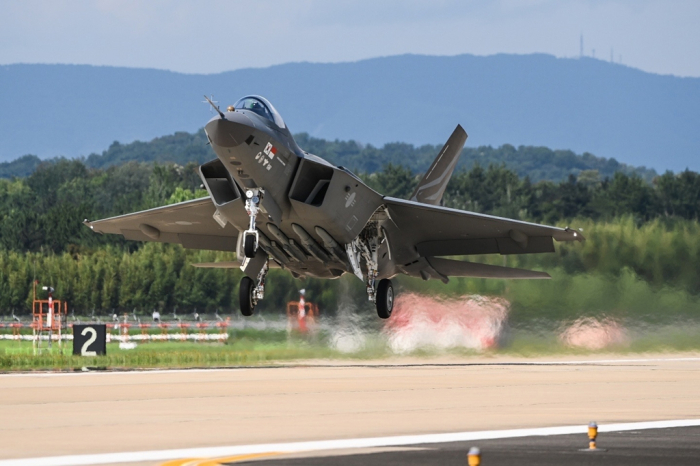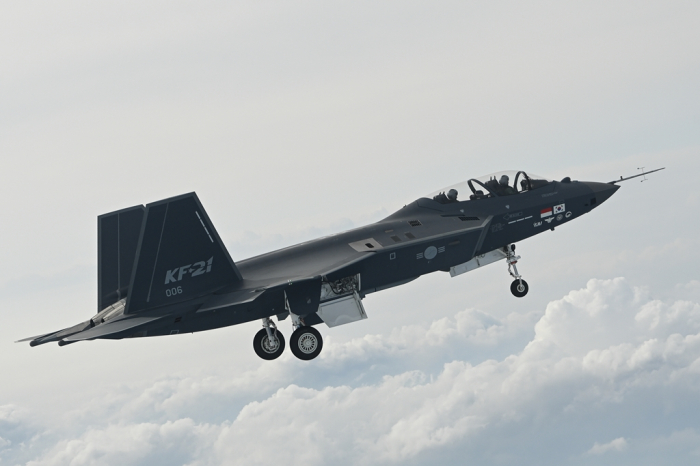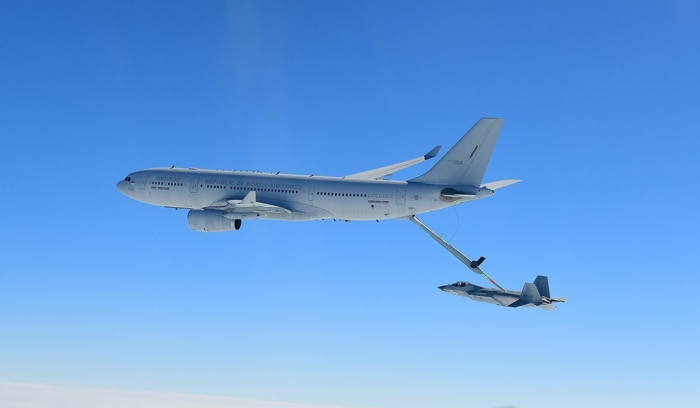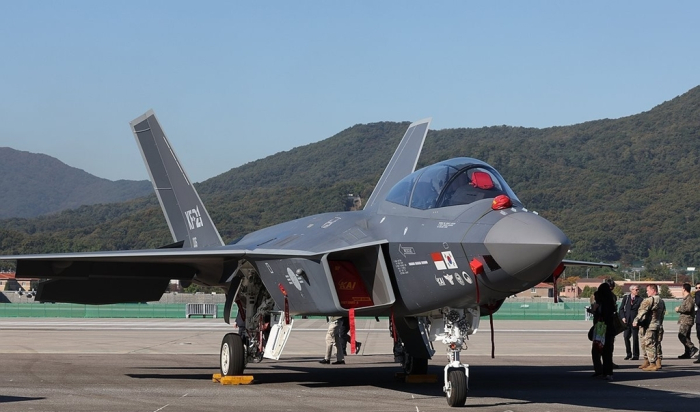South Korea to accept Indonesia’s KF-21 project cost cut proposal
With reduced payments from Jakarta, Seoul says it will adjust the size of related technology transfers
By May 08, 2024 (Gmt+09:00)
When in S. Korea, it’s a ritual: Foreigners make stops at CU, GS25, 7-Eleven


Maybe Happy Ending: A robot love story that rewrote Broadway playbook


Samsung steps up AR race with advanced microdisplay for smart glasses


NPS yet to schedule external manager selection; PE firms’ fundraising woes deepen


US auto parts tariffs take effect; Korea avoids heavy hit



South Korea plans to accept Indonesia’s request to cut its share of payments for a joint fighter jet development project to one-third of the originally agreed amount after Jakarta repeatedly reneged on its promise to pay in full.
The Defense Acquisition Program Administration (DAPA), Korea’s state-run arms procurement agency, on Wednesday confirmed that Indonesia recently proposed cutting its payments for the KF-21 project.
Indonesia said it would receive fewer technology transfers from Korea as part of its move to cut its financial contribution, according to the agency.
“Indonesia has proposed paying 600 billion won ($440 million) by the end of 2026. We are positively considering accepting the proposal,” DAPA said in a statement. “We’re also working on a plan to adjust the scale of technology transfers in line with the reduced financial contribution.”
A DAPA official said: “A continued deadlock over Indonesia’s failed payments will affect the KF-21 fighter jet development schedule, which in turn will delay the planned deployment of new fighter jets.”

The agency said it will likely make the final decision at a DAPA review committee meeting later this month after consultations with related ministries, including the Defense Ministry and the Finance Ministry.
KOREA’S HOMEGROWN TECH
The KF-21 is a joint project between Korea and Indonesia to develop a next-generation supersonic fighter plane using Korean homegrown technology for key components.
In 2016, Indonesia agreed to shoulder some 1.7 trillion won, or some 20% of the multi-billion-dollar project in return for the Southeast Asian country receiving a prototype of the fighter jet and technical support for the local production of 48 units in Indonesia.
The Korean government was slated to cover 60% of the total cost while Korea Aerospace Industries Ltd. (KAI), Korea’s only military aircraft maker, said it would finance the remaining 20%.
Indonesia's amount was later set at 1.6 trillion won. Jakarta has so far paid some 300 billion won and has missed interim payment deadlines several times.

Industry officials said Korea has decided to accept Indonesia’s proposal partly due to the lower-than-expected development costs.
DAPA initially estimated the KF-21 project to cost 8.1 trillion won but now expects the expenditures to come in around 7.6 trillion won after rigorous cost-cutting.
“Even with the reduced contribution from Indonesia, we expect the Korean side to shoulder an extra 500 billion won,” said the DAPA official.
NEXT-GENERATION FIGHTER JET FOR KOREA’S AIR FORCE
In April 2021, Korea unveiled a prototype of the KF-21 fighter jet, nicknamed Boramae, at KAI in Sacheon, South Gyeongsang Province.

Korea plans to gradually replace the country’s aging fleet of F-4 and F-5 fighters, third-generation US-designed jets introduced in the 1960s.
Once fully operational, the KF-21 combat plane, dubbed a 4.5-generation jet because of the lack of a stealth function, is expected to replace Korea's fourth-generation F-16s and F-15Ks.
The new plane boasts a maximum payload of 7,700 kilograms and 10 pods for air-to-air missiles and other weapons. It can reach a speed of 2,200 kph with a flying range of 2,900 km.
Last year, the KF-21 made its first supersonic flight over Korean skies.
DAPA said in January that KAI will likely begin mass production of the new warplane this year for initial delivery to the Korean Air Force in the second half of 2026.
“We will keep proving the KF-21’s performance through various flight assessments, including aerial refueling and air-to-air missile launch tests,” said DAPA Minister Eom Donghwan.
Write to Dong-Hyun Kim at 3code@hankyung.com
In-Soo Nam edited this article.
-
 Aerospace & DefenseS.Korea to mass-produce homegrown fighter jet in 2024
Aerospace & DefenseS.Korea to mass-produce homegrown fighter jet in 2024Jan 10, 2024 (Gmt+09:00)
1 Min read -
 Aerospace & DefenseS.Korea mulls plan B as Indonesia falls behind on KF-21 project payments
Aerospace & DefenseS.Korea mulls plan B as Indonesia falls behind on KF-21 project paymentsNov 01, 2023 (Gmt+09:00)
4 Min read -
 Aerospace & DefenseS.Korean fighter jet KF-21 makes first supersonic flight
Aerospace & DefenseS.Korean fighter jet KF-21 makes first supersonic flightJan 18, 2023 (Gmt+09:00)
1 Min read -
 Aerospace & DefenseKorea's domestic jet fighter KF-21 completes first flight test
Aerospace & DefenseKorea's domestic jet fighter KF-21 completes first flight testJul 19, 2022 (Gmt+09:00)
3 Min read -
 Aerospace & DefenseS.Korea rolls out next-generation fighter jet KF-21 with local technology
Aerospace & DefenseS.Korea rolls out next-generation fighter jet KF-21 with local technologyApr 09, 2021 (Gmt+09:00)
3 Min read


